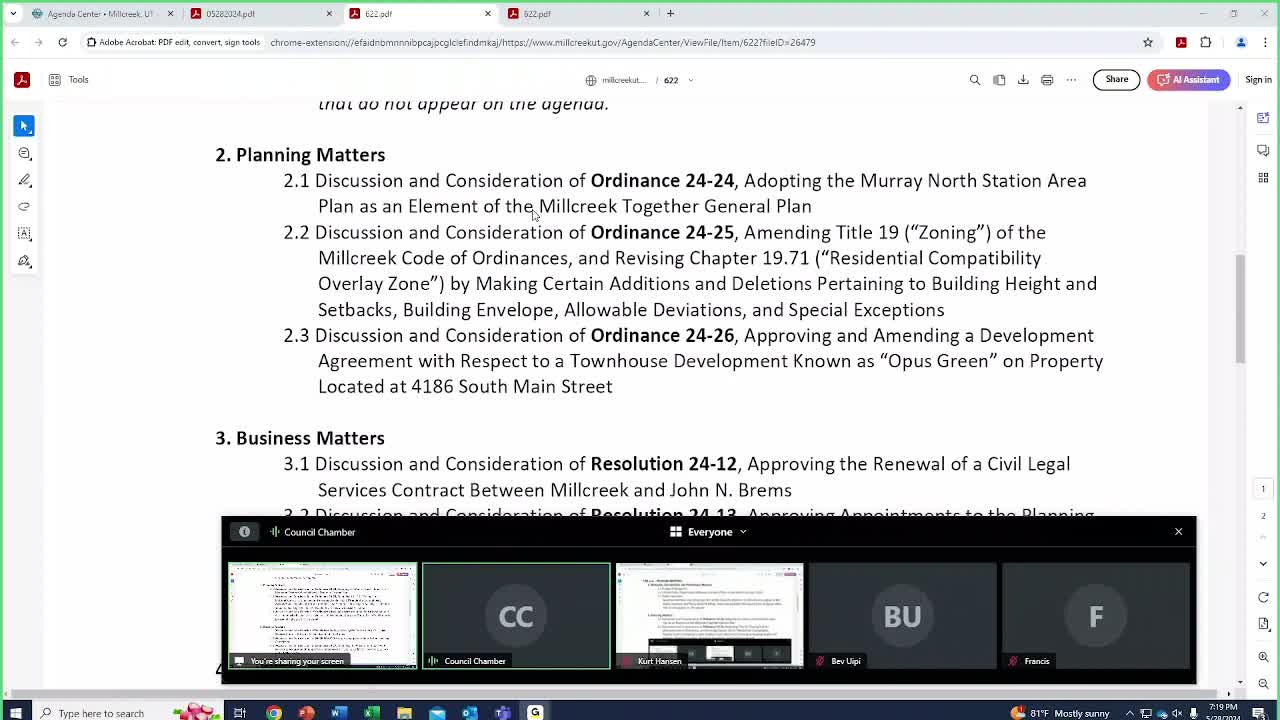Mill Creek plans vibrant community transformation around North Station
May 28, 2024 | Millcreek City Council, Millcreek, Salt Lake County, Utah

This article was created by AI summarizing key points discussed. AI makes mistakes, so for full details and context, please refer to the video of the full meeting. Please report any errors so we can fix them. Report an error »

During a recent government meeting, the Mill Creek City Council discussed several key ordinances aimed at enhancing community development and addressing housing needs.
The council began with the adoption of Ordinance 24-24, which approves the Murray North Area Station Plan as part of the Mill Creek General Plan. Erica Chmielewski from GSBS Consulting presented the plan, emphasizing the need for collaboration between Mill Creek and Murray to create a vibrant, accessible neighborhood. The plan focuses on increasing housing diversity and improving public spaces, with a five-year implementation strategy that includes enhancing connectivity and safety in the area surrounding the transit station.
Following this, the council unanimously approved Ordinance 24-25, which amends the residential compatibility overlay zone. This ordinance aims to expedite building processes by increasing the allowable building height from 28 to 30 feet and revising setback requirements, thereby facilitating construction on smaller lots. The changes are intended to support residents and builders during the current construction season.
The council also addressed the Opus Green development agreement, amending it to extend the deadline for a commercial component due to pandemic-related delays. This extension allows the developer until February 2026 to meet the original agreement's requirements, while also considering a potential redesign of the commercial space to better serve the community.
In addition to these ordinances, the council renewed a civil legal services contract with city attorney John Brems, recognizing his valuable contributions to the city. They also reappointed two members to the planning commission, ensuring continuity in leadership and expertise.
The meeting concluded with discussions on various community initiatives, including a report on the recent Skyline Super Reunion, which celebrated the legacy of the local high school, and updates on the Wasatch Front Waste and Recycling District's management of the scrap program.
Overall, the council's decisions reflect a commitment to improving housing options, enhancing community infrastructure, and fostering collaboration between neighboring municipalities.
The council began with the adoption of Ordinance 24-24, which approves the Murray North Area Station Plan as part of the Mill Creek General Plan. Erica Chmielewski from GSBS Consulting presented the plan, emphasizing the need for collaboration between Mill Creek and Murray to create a vibrant, accessible neighborhood. The plan focuses on increasing housing diversity and improving public spaces, with a five-year implementation strategy that includes enhancing connectivity and safety in the area surrounding the transit station.
Following this, the council unanimously approved Ordinance 24-25, which amends the residential compatibility overlay zone. This ordinance aims to expedite building processes by increasing the allowable building height from 28 to 30 feet and revising setback requirements, thereby facilitating construction on smaller lots. The changes are intended to support residents and builders during the current construction season.
The council also addressed the Opus Green development agreement, amending it to extend the deadline for a commercial component due to pandemic-related delays. This extension allows the developer until February 2026 to meet the original agreement's requirements, while also considering a potential redesign of the commercial space to better serve the community.
In addition to these ordinances, the council renewed a civil legal services contract with city attorney John Brems, recognizing his valuable contributions to the city. They also reappointed two members to the planning commission, ensuring continuity in leadership and expertise.
The meeting concluded with discussions on various community initiatives, including a report on the recent Skyline Super Reunion, which celebrated the legacy of the local high school, and updates on the Wasatch Front Waste and Recycling District's management of the scrap program.
Overall, the council's decisions reflect a commitment to improving housing options, enhancing community infrastructure, and fostering collaboration between neighboring municipalities.
View full meeting
This article is based on a recent meeting—watch the full video and explore the complete transcript for deeper insights into the discussion.
View full meeting

